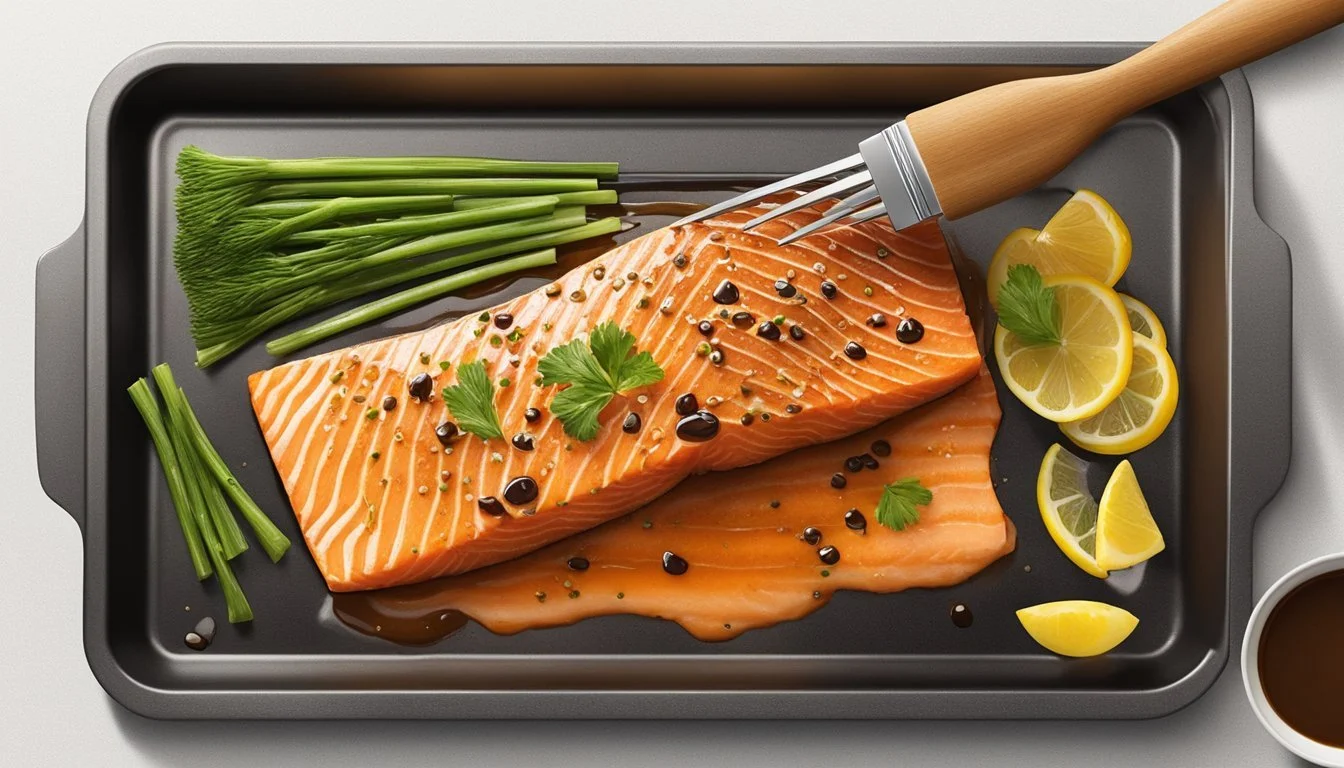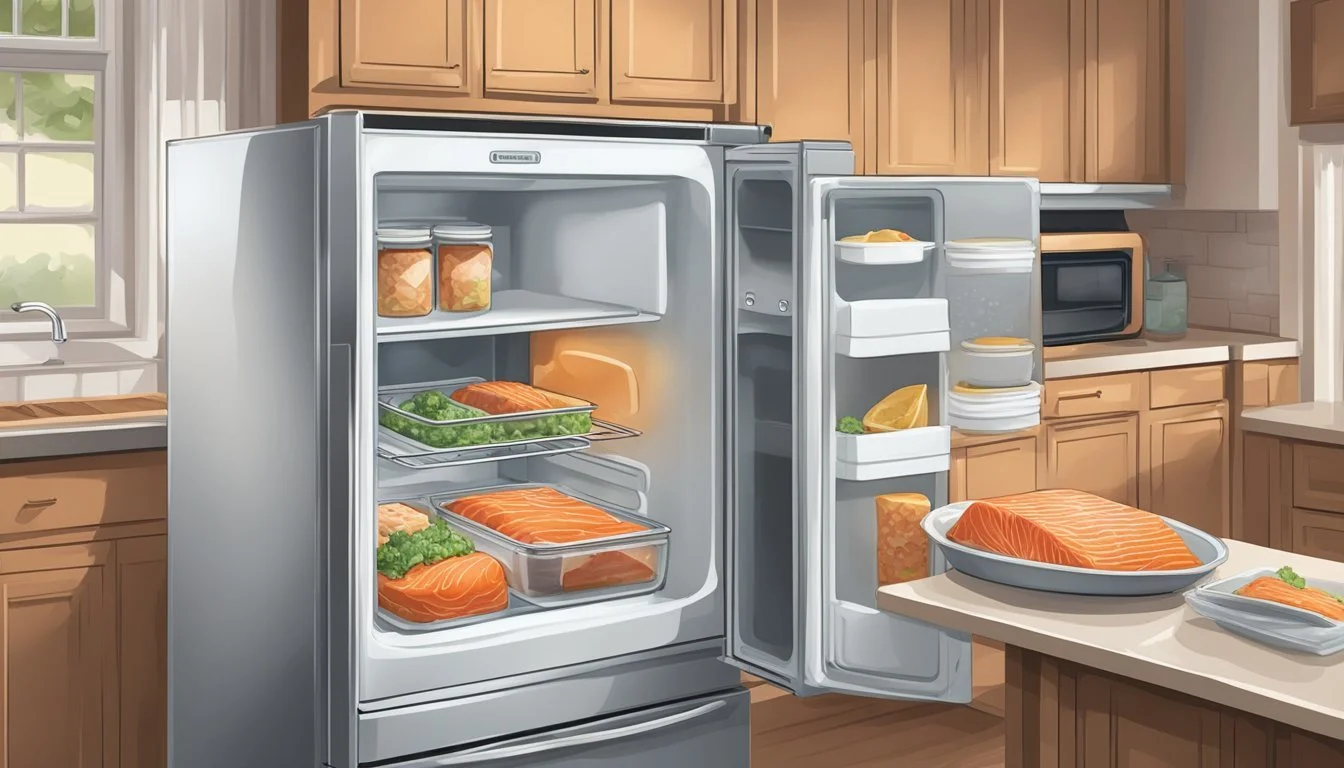Best Way to Reheat Baked Salmon with Teriyaki Glaze
Keeping It Succulent and Flavorful
Reheating baked salmon, particularly when it's glazed with a flavorful teriyaki sauce, requires careful attention to preserve its moisture and delicate texture. The key is to apply a gentle heat that warms the fish without causing it to dry out. To achieve this balance, one must consider the tools and methods most effective for maintaining the salmon's succulent quality. An optimal reheating technique not only restores the warmth of the dish but also revitalizes the savory glaze that makes teriyaki salmon a delightful meal.
One of the most common methods for reheating involves the use of an oven, which can evenly reheat the salmon while keeping the moisture locked in, especially when the fish is loosely covered with foil. This method allows for a controlled environment where the salmon gently reaches the desired temperature without the risk of overcooking. It is vital to start by allowing the salmon to reach room temperature for a short period before reheating to ensure even warmth distribution. Utilize the lowest effective temperature setting to reheat the salmon to help maintain its juiciness and to prevent the teriyaki glaze from burning or becoming overly sticky.
Understanding Salmon Reheating Fundamentals
Successfully reheating baked salmon with a teriyaki glaze revolves around understanding how heat affects the protein structure and ensuring moisture retention to preserve the delicate texture and rich flavors.
Protein Structure and Heat Interaction
When one heats salmon, the protein fibers contract, potentially leading to a dry and tough texture if overheated. Salmon should be brought gently to the desired internal temperature of 145 degrees Fahrenheit (63 degrees Celsius). This temperature ensures the fish is warmed through without altering its tender structure. The presence of omega-3 fatty acids plays a role in maintaining the salmon's inherent moisture and contributes to the pleasant aroma that is characteristic of properly reheated salmon.
Moisture Retention Techniques
To counteract moisture loss during the reheating process, several techniques should be employed:
Use aluminum foil to cover the salmon, creating a moisture-locking tent.
Introduce a small amount of water or a drizzle of olive oil on the salmon before covering to help maintain moisture levels.
Allow the glazed salmon to sit at room temperature for about 10-15 minutes prior to reheating to ensure an even distribution of heat.
By understanding the protein structure and effectively managing moisture, one can avoid the dreaded overcooked salmon texture and enjoy a dish that's remarkably close to its freshly-cooked state.
Best Reheating Methods for Salmon
Achieving perfectly moist reheated salmon with a teriyaki glaze is attainable with the right techniques. The following methods ensure that the salmon retains its moisture and flavor.
Oven Reheating
To reheat salmon in the oven, one should preheat their oven to a low temperature, typically around 275°F to 300°F. The salmon should be placed on a baking sheet lined with foil or parchment paper to prevent sticking. Cover the salmon loosely with aluminum foil to keep the moisture in and reheat for about 15 minutes or until the internal temperature reaches 145°F.
Temperature: 275°F – 300°F
Time: Approximately 15 minutes
Tools: Baking sheet, aluminum foil
Stovetop Reheating
Reheating salmon on a stovetop involves using a non-stick skillet or frying pan. One should add a small amount of oil or water to the pan to provide moisture and prevent the salmon from drying out. Place the salmon in the pan, cover with a lid, and heat on low to medium heat until warmed through.
Heat: Low to medium
Tools: Non-stick skillet, lid
Microwave Reheating
Although not ideal for preserving moisture, the microwave can be a quick method to reheat salmon. To do so, one should place the salmon in a microwave-safe dish, add a splash of water, and cover with a microwave-safe lid or plastic wrap. Use a lower power setting and heat in short intervals, checking for even heating.
Power Setting: Low
Time: Short intervals
Tools: Microwave-safe dish, cover
Air Fryer Reheating
An air fryer can be utilized to reheat salmon quickly while maintaining a good texture. To use this method, place the salmon in the air fryer basket and set it to approximately 350°F. Heat for a few minutes until just heated through. Watching the salmon closely prevents overcooking.
Temperature: 350°F
Time: A few minutes
Grill Reheating
Grill reheating is another option for salmon with a teriyaki glaze, infusing a smoky flavor. Reheat the salmon on a low indirect heat, placing it on a sheet of foil for protection. Close the grill lid and allow the salmon to heat up gently, ensuring it does not dry out or overcook.
Heat: Low, indirect
Tools: Grill, foil
Preparatory Steps Before Reheating
Proper preparation is crucial for reheating baked salmon with teriyaki glaze to preserve its moisture and flavor. The preparatory steps revolve around properly thawing the fish and ensuring it's seasoned and moist before applying heat.
Thawing and Bringing to Room Temperature
Baked salmon should be gradually thawed if frozen, ideally in the refrigerator. The goal is to maintain an even and safe temperature transition. Once thawed, or if starting with refrigerated leftover salmon, allow it to come to room temperature for 10-15 minutes before reheating. This helps ensure a more even reheating process, reducing the risk of drying out the delicate fish.
Adding Moisture and Flavor
To add moisture and assist in preserving the teriyaki glaze's integrity, one can employ several methods:
Moisture Addition: Lightly drizzle olive oil or melted butter over the salmon. This adds a layer of fat which helps to lock in moisture.
Flavor Enhancement: Infuse additional flavors that complement the teriyaki glaze, such as a squeeze of lemon juice or a touch of minced garlic.
Utilizing Coverings:
Covering Method Purpose Foil Loosely tenting foil over the salmon prevents moisture loss while allowing heat to circulate. Lid Using a lid over a skillet provides a similar effect, trapping steam and warmth. Paper Towel A dampened paper towel over the salmon in a microwave-safe dish can contribute moisture during the reheating process.
Remember, the key is to gently add moisture without overwhelming the existing teriyaki flavors.
Handling Teriyaki Glazed Salmon
When reheating teriyaki glazed salmon, the aim is to preserve the moisture of the fish and maintain the integrity of the glaze. Ensuring the glaze doesn't become too dry or lose its flavor is key.
Protecting the Teriyaki Glaze
To preserve the glaze's moisture and prevent it from burning, one can lightly cover the salmon with aluminum foil during reheating. This helps to retain moisture and heat the salmon evenly. For a crispy outer layer, the foil can be removed in the final minutes of reheating. If the glaze has reduced too much, basting the salmon with a little extra sauce can prevent drying out. Here’s a suggested method:
Preheat your oven or pan.
Cover the salmon with foil.
Heat until warm to the touch.
Remove foil and baste if the glaze has thinned.
Enhancing Glaze Flavor During Reheating
For those who enjoy a richer flavor or need a gluten-free option, consider using gluten-free soy sauce or tamari in the homemade teriyaki sauce. A small addition of honey or maple syrup to the teriyaki sauce can enrich the glaze and add a delicate sweetness that complements the savory elements. Sesame oil can provide a nutty aroma and deeper taste. To enhance the glaze during reheating, brush the salmon with a mixture of teriyaki sauce and the chosen sweetener, and add a drop of sesame oil for that aromatic finish. Here's a tip:
Mix: Combine a small amount of teriyaki sauce with honey or maple syrup, and a dash of sesame oil.
Brush: Gently brush the mixture over the salmon before and after reheating.
Avoiding Common Reheating Mistakes
Reheating baked salmon, especially with a teriyaki glaze, requires careful attention to prevent overcooking and dryness. Keeping the temperature low and heating evenly are essential steps to maintaining the salmon’s quality.
Prevent Overcooking
One should reheat salmon slowly and at a low temperature to avoid overcooking. For oven reheating:
Temperature: 275°F (135°C)
Time: 10-15 minutes
Doneness Check: Internal temperature should reach 145°F (63°C), or until it is heated throughout.
Microwave:
Use low power or the "defrost" setting, and heat in short 30-second bursts, checking frequently to prevent overcooking.
Air Fryer:
Not recommended for glazed salmon due to high heat circulation that can quickly overcook and burn the glaze.
Grill:
Avoid using the grill to reheat salmon with teriyaki glaze, as it's difficult to control the even heat needed.
Avoiding Dryness and Uneven Heating
To counteract dryness and uneven heating:
Oven Method:
Cover with Foil: This retains moisture and distributes heat evenly.
Optional: Add a small amount of water or a brush of the reserved teriyaki glaze to the baking dish to enhance moistness.
Microwave Method:
Cover: Use a microwave-safe lid or vented plastic wrap to trap steam.
Rotate: If the microwave doesn't have a turntable, rotate the dish manually halfway through reheating.
Air Fryer Method:
Since the air fryer is not recommended for glazed salmon, there's no method advised to prevent dryness using this appliance.
Grill Method:
If one must use a grill, keep the salmon on indirect heat and watch closely, although this method provides the least control over even heating and moisture retention.
Serving and Pairing Reheated Salmon
Reheating salmon with a teriyaki glaze offers an opportunity to enhance the dish's flavor profile by thoughtfully choosing sides and presentation methods that complement the sweet and savory notes of teriyaki.
Accompaniments That Complement Teriyaki Salmon
Vegetables: Steamed or sautéed vegetables such as broccoli or roasted asparagus make for a healthful and colorful addition.
Grains: Serve alongside a bed of brown rice which not only balances the dish but also absorbs the teriyaki glaze, boosting the overall flavor.
Garnishes: A sprinkle of sesame seeds and chopped green onion adds a fresh and aromatic finish to the dish.
Presentation Tips
Transfer the reheated salmon onto a serving plate carefully, ensuring it maintains its form.
Aesthetic appeal: Drizzle the remaining teriyaki glaze over the salmon and garnish with sesame seeds and green onion to elevate the visual presentation.
Interaction of elements: Arrange the prepared sides around the salmon to create a harmonious and appealing plate that invites diners to enjoy the combination of flavors.
Proper Storage for Leftover Salmon
When storing leftover salmon, whether it's cold or baked with a teriyaki glaze, maintaining freshness and flavor is paramount. Refrigeration is crucial to prolong the shelf life of salmon leftovers. It's recommended to refrigerate the salmon within two hours of cooking.
Steps for Storing in the Refrigerator:
Cooling: Allow the salmon to cool to avoid raising the refrigerator's internal temperature, which can lead to food spoilage.
Airtight Container: Place the leftover salmon in an airtight container. This minimizes exposure to air and bacteria that can hasten spoilage.
Maximize Freshness: Consume the refrigerated salmon within 3 days for optimal taste and safety.
For Smoked Salmon:
Smoked salmon has a longer shelf life due to the curing process. Store it in the coldest part of the refrigerator, tightly wrapped or in an airtight container.
Table: Storage Overview
Salmon Type Container Type Refrigeration Time Baked Salmon Airtight Up to 3 days Smoked Salmon Airtight/Tightly Wrapped As per packaging, usually longer than baked
Proper storage is key to ensure the leftover salmon remains safe to eat and delicious. Reheating, when done correctly, can bring back the warmth and enhance its flavors without drying out the delicate fish.





